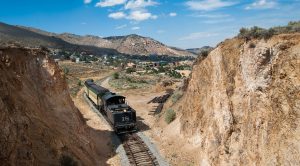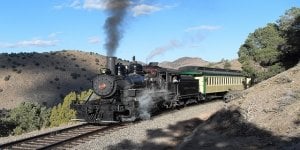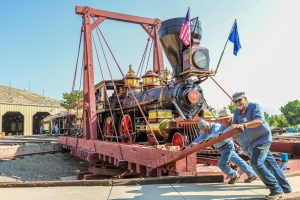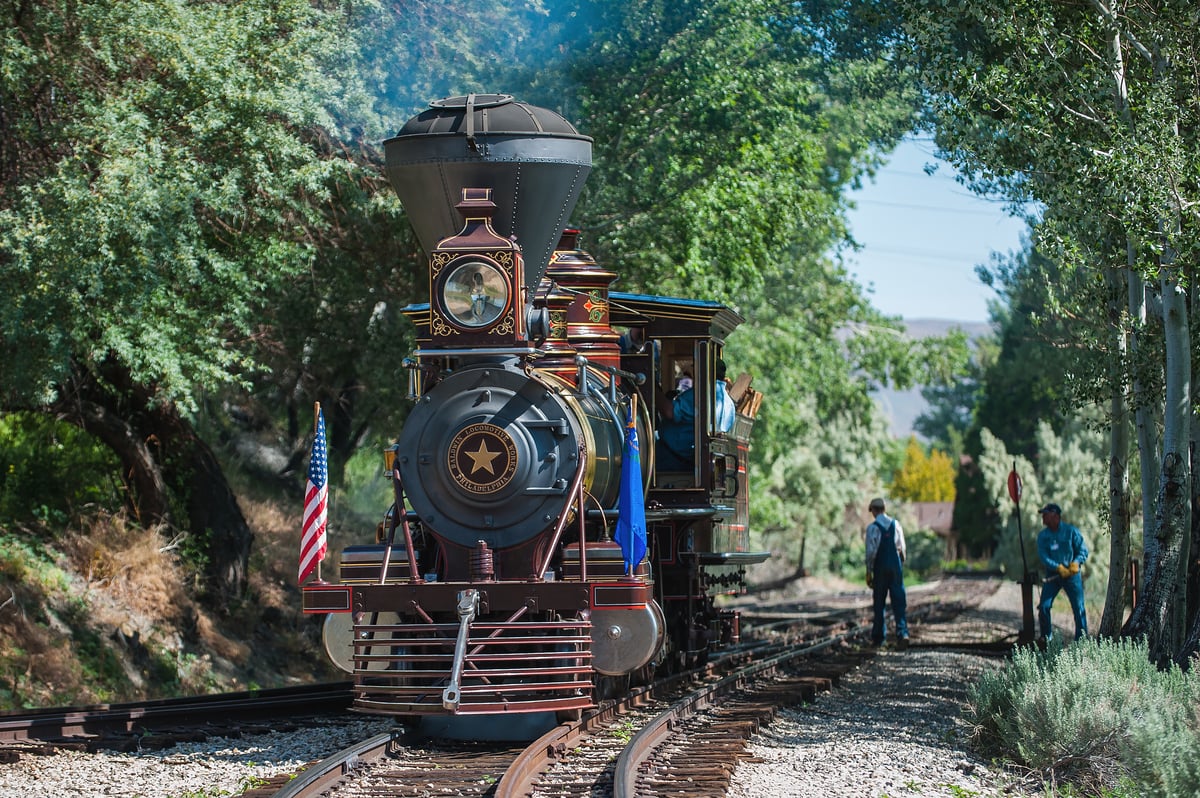Carson City’s roots run deep in train history.
With two train attractions and a plethora of history told in our museums, it’s a must stop for train-lovers.
The Virginia & Truckee Railroad

Following the discovery of rich silver and gold deposits in Virginia City, it soon became apparent that something beside freight wagons was needed to carry heavy ore from the mines to the mills along the Carson River for refining. Additionally, a better transportation system was needed to bring lumber from the Lake Tahoe region to Virginia City, where it could be used to timber the underground mines and feed the mining furnaces.
To address these needs, William Sharon and his Bank of California partners incorporated the Virginia and Truckee Railroad Company in March 1868. The plan was to build the railway between Virginia City and the Carson River (near present day Mound House) and extend it later to Carson City and Reno. Work began in February 1869 and by early the following year regular train service was established between Virginia City and Carson City.
By 1872, the line had been extended to Reno, where it intersected with the Central Pacific Railroad, and ultimately the transcontinental railroad that had been completed in 1869. In the early to mid-1870s, Virginia City’s mines were so productive that from 30 to 45 trains operated daily on the 55-mile-long railroad, which, because of its winding route became known as the “Very Crooked and Terribly Rough Railroad.” Additionally, in 1880 work began on a second railway, the Carson & Colorado Railroad, which operated between Mound House, where it connected with the V & T, to mining districts to the south and southeast such as Candelaria and Aurora. The V & T’s fortunes began to wane with the decline of mining in the Virginia City area in the 1880s.
By the turn of the century, the railway had shifted its focus from transporting ore to carrying tourists and other passengers. In 1906, the V & T was extended south of Carson City to Minden. The railroad’s financial situation worsened after 1924, when mining had virtually stopped in Virginia City. The railroad struggled to stay in business during the next 26 years (with the unprofitable Virginia City to Mound House spur shut down in 1938), losing money in each succeeding year. In 1950, the line was formally abandoned and the railroad’s historic rolling stock was sold to Paramount Studios.
Learn more at vtrailway.com
Rebuilding a Legend
 The rebirth of the V & T Railroad began in 1972 when Robert Gray, a railroad enthusiast from Sacramento, California, acquired a portion of the V & T right of way and began reconstructing the historic route. He laid the first tie in 1974 and started running his train for tourists three years later. Despite setbacks, such as collapsed tunnels, steep grades, and aging equipment, Gray, his staff, and many volunteers persevered.
The rebirth of the V & T Railroad began in 1972 when Robert Gray, a railroad enthusiast from Sacramento, California, acquired a portion of the V & T right of way and began reconstructing the historic route. He laid the first tie in 1974 and started running his train for tourists three years later. Despite setbacks, such as collapsed tunnels, steep grades, and aging equipment, Gray, his staff, and many volunteers persevered.
A few years ago, the V & T line had extended a few miles down the hill from Virginia City when it reached the entrance to the original Tunnel 3. Gray and his workers tried to reconstruct the tunnel but found it impossible to do so safely. The railroad was forced to extend the track around the hill, avoiding the tunnel. The result, however, is an even more spectacular trip as the train slowly sweeps around the side of a hill, offering a panoramic view of Gold Hill and the surrounding environs.
Presently, the train runs from a small depot on F Street, just south of the St. Mary’s in the Mountains Catholic Church, to the Gold Hill Depot (a 35-minute ride that covers a little under six miles). During the leisurely ride, travelers are treated to an informative talk as the conductor relates anecdotes about the Comstock and points out places of historic interest along the way, including original mining head frames, mill sites and other buildings. The Virginia and Truckee Railroad Company operates from Memorial Day until the end of October. For more information call 775.847.0380.
Full Steam Ahead: Reconstruction of the V & T

When visiting Carson City, you can now hop aboard the reconstructed V&T Railway and take a beautiful scenic ride up to Virginia City. Take a round trip or one-way ride.
In the early 1990s, V & T enthusiasts along with Storey County, Carson City, and state officials began studying the possibility of reconstructing the historic rail line between Virginia City and Carson City. A financial study was commissioned, which indicated that the railroad was feasible, and the non-profit Nevada Commission for the Reconstruction of the V & T Railway was created to raise money for the project, estimated to cost $25 million when completed.
Additionally, the commission purchased a 1914 Baldwin steam locomotive from a defunct Northern California tourist railroad. The Nevada Legislature provided additional funds to help keep the project going while the Department of Transportation donated a railroad bridge formerly used in Southern Nevada for a crossing over U.S. 50, once the rebuilt railroad reaches that point.
The reconstructed railroad follows the original railroad right-of-way between Virginia City and Carson City. It incorporates the Virginia and Truckee Railroad Company’s 2.5 miles of existing track from Virginia City to the Gold Hill Depot. From there, it crosses the filled-in Overman Pit and continue through American Flat, a former mining mill district near Silver City, before reaching U.S. 50 near Mound House. The route crosses the highway and enters the Carson River Canyon area, where it winds along the banks of the river, offering spectacular views. It concludes its 21-mile route in Carson City.
Book a ride on the V&T Railway!
The Nevada State Railroad Museum
 Separate from the V&T Railway attractions, Carson City offers a second stop for train enthusiast.
Separate from the V&T Railway attractions, Carson City offers a second stop for train enthusiast.
The Nevada State Railroad Museum preserves the railroad heritage of Nevada, including locomotives and cars of the famous Virginia and Truckee Railroad. Much of the museum equipment was obtained from Hollywood studios, where they were often featured in movies and television. The museum is operated by the Nevada Department of Tourism and Cultural Affairs.
Museum activities consist of operation of historic 4 ft 7 in (1,435 mm) standard gauge and 3 ft (914 mm) narrow gauge railroad equipment, including train rides, handcar rides, lectures, an annual railroad history symposium, changing exhibits, and a variety of special events. The Museum also has an ongoing research and restoration program. The Museum’s most recent event is the rebuilding of the interpretation center and possibly the HO scale model railroad operated by the Carson Model Railroaders who operate to Mills Park Railroad.
